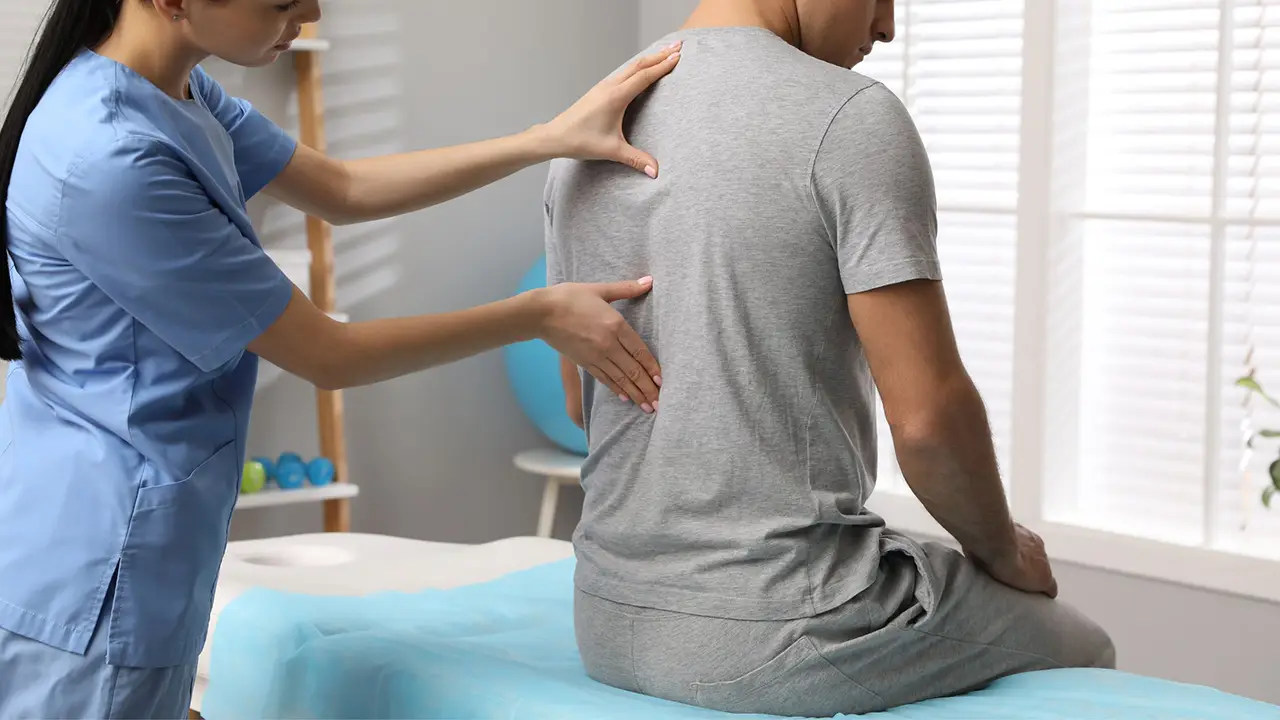Effective Relief for Lower Back Pain, Stiffness, and Nerve Irritation
Lumbar spondylosis refers to the age-related degeneration of the lower spine (lumbar region), often involving the intervertebral discs, facet joints, and surrounding ligaments. It is one of the most common causes of chronic lower back pain and stiffness, especially in adults over 40.
At Starcare International Hospital, we offer expert diagnosis and multi-modal treatment options for lumbar spondylosis—ranging from personalized physiotherapy and pain management to advanced surgical care for patients who need it. Our goal is to reduce pain, improve spinal function, and restore mobility through safe and effective solutions.
What Is Lumbar Spondylosis?
Lumbar spondylosis is a form of spinal osteoarthritis that results from natural wear and tear over time. It can lead to:
-
Disc degeneration (loss of disc height and flexibility)
-
Bone spur formation (osteophytes)
-
Thickening of spinal ligaments
-
Facet joint arthritis
-
Nerve root or spinal cord compression in advanced cases
The condition may remain asymptomatic in its early stages but can progress to cause persistent back pain, reduced flexibility, and radiating nerve pain (sciatica).
Causes and Risk Factors
-
Natural aging and spinal degeneration
-
Poor posture or prolonged sitting
-
Repetitive strain from heavy lifting or twisting
-
Obesity and sedentary lifestyle
-
History of spinal injury
-
Family history of degenerative spine conditions
Common Symptoms
-
Dull, aching or sharp lower back pain
-
Morning stiffness that improves with movement
-
Pain that worsens with prolonged sitting or standing
-
Sciatica – radiating leg pain, tingling, or numbness
-
Limited spinal flexibility or mobility
-
Muscle spasms or fatigue in the lower back
-
Difficulty bending, lifting, or walking long distances
In some cases, lumbar spondylosis can also lead to spinal stenosis (narrowing of the spinal canal), causing nerve compression and more severe symptoms.
Diagnosis at Starcare
We begin with a thorough history and physical examination followed by imaging studies:
-
X-rays to detect disc space narrowing, bone spurs, and alignment issues
-
MRI to assess disc degeneration, nerve compression, and soft tissue inflammation
-
CT scan for detailed bony anatomy
-
Nerve conduction studies (EMG/NCV) if neurological symptoms are present
Accurate diagnosis helps us plan the most effective and least invasive course of treatment.
Non-Surgical Treatment Options
Most patients with lumbar spondylosis benefit from conservative, non-surgical therapies:
1. Physiotherapy
-
Core strengthening and stretching exercises
-
Postural correction and ergonomic training
-
Manual therapy and spinal mobilization
-
Gait retraining and lumbar stabilization
2. Medications
-
Non-steroidal anti-inflammatory drugs (NSAIDs)
-
Muscle relaxants
-
Neuropathic pain medications (for nerve symptoms)
3. Pain Management Injections
-
Epidural steroid injections
-
Facet joint or nerve root blocks
-
Trigger point injections
4. Lifestyle Modifications
-
Weight management
-
Low-impact physical activity
-
Workplace and sleep ergonomics
Our multidisciplinary team works together to help you build long-term habits that support spinal health and function.
Surgical Treatment (for Severe or Unresponsive Cases)
Surgery may be considered when:
-
Pain persists after 8–12 weeks of conservative treatment
-
There is significant nerve compression with weakness or numbness
-
MRI shows spinal stenosis, disc herniation, or vertebral instability
-
Symptoms severely affect quality of life
Surgical options include:
-
Lumbar decompression (laminectomy or foraminotomy) to relieve nerve pressure
-
Discectomy to remove herniated disc material
-
Spinal fusion to stabilize unstable segments
-
Minimally Invasive Spine Surgery (MISS) for quicker recovery and less trauma
Our spine surgeons are skilled in both traditional and minimally invasive techniques, prioritizing patient safety and faster healing.
Recovery and Long-Term Care
-
Return to daily activity within 2–6 weeks depending on treatment
-
Long-term spine health supported by guided physiotherapy
-
Regular follow-up to monitor symptom improvement and spinal function
-
Prevention strategies including posture training, exercise, and bone health optimization
Why Choose Starcare for Lumbar Spondylosis Treatment?
-
Dedicated spine specialists with global expertise in degenerative spine care
-
Comprehensive non-surgical and surgical solutions under one roof
-
Advanced diagnostics and precision-guided injections
-
Emphasis on patient education and self-care
-
Personalized recovery plans focused on long-term wellness
At Starcare, we are committed to helping you manage lumbar spondylosis with confidence—so you can move better, feel stronger, and live pain-free.

